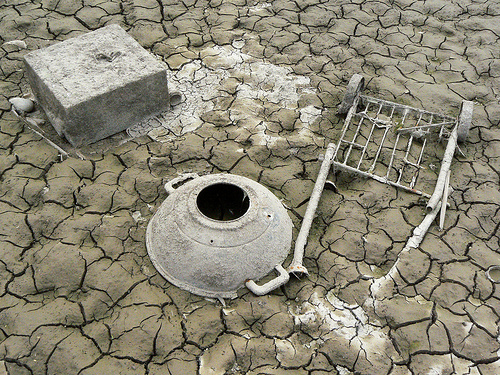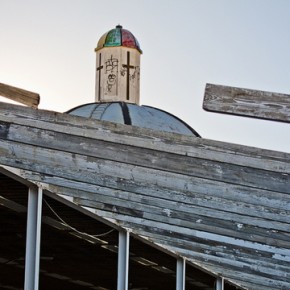Arizona murdered its rivers and poured the remains onto cotton fields and golf courses. Some of the largest water engineering projects on the planet have gone into producing suburban swimming pools and green lawns. Today’s Arizona could not exist without the diversion and destruction of its river system. Over 90 percent of the state’s river system has disappeared.
One of the first impressions Arizona makes on visitors is the massive disproportion between the scale of its human development and the absence of sufficient visible water resources. Perhaps it is a primitive instinct coming to the fore, an instinct that warns us of danger. No water means a threat to life. Yet we learn to trust the water engineering that fills household pipes and large ponds in well-heeled suburbs. That danger-sense subsides and Arizona residents grow comfortable.
Environmental discomfort is more prudent. Ken Lamberton’s Dry River: Stories of Life, Death, and Redemption on the Santa Cruz (University of Arizona Press, 2011) traces the history of Euro-American use of a small southern Arizona river and the damages inflicted. Lamberton’s writing finds its signature characteristic in interpolation of nature with personal and social histories. Our dependence and interaction with natural forces remain present even in the most ‘unnatural’ of environments. Since Arizona suburbs are built upon alienation from nature, such a reminder message is much needed.
European conquest of the American Southwest took far longer than the rest of the United States. That colonial conquest related to exploitation of water resources as much as to population settlement and cultural incorporation. Arizona river water attracted European attention as early as the mid-sixteenth century, but only at the end of the seventeenth-century did Father Kino establish the first Jesuit missions along the Santa Cruz River. Over the course of the nineteenth century Arizona successively shifted from the Spanish empire, to independent Mexico, to the new US empire.
Water use increased throughout the twentieth century even as the state’s agriculture began to decline, part of Arizona’s economic transformation. In the 1940s, Lamberton’s father-in-law remembers fishing from a Tucson bridge over the Santa Cruz. These were the last days of the river’s life near Tucson. Soon it had been pumped dry and turned into a dry wash. Species endangerments and extinctions accompanied the drying out of Arizona rivers. Of nearly 40 native Arizona fish, the majority are threatened, endangered or extinct. Overuse and abuse severely degraded the quality of the river in those stretches where it continued to flow.
Lamberton’s exploration of the river follows its stages, from its headwaters in the San Rafael Valley, then its swing south over the Mexico-US border into Sonora, then northward through Guevavi, Calabesas, Tumacacori, the Tohono O’odham reservation (requiring a tribal council approval vote for Lamberton to cross), and past Tucson. His walks and rides along the reaches of the Santa Cruz provide opportunities for historical and family digressions, pleasant narrative meanders. These travels stretch over 200 miles along the course of the Santa Cruz River until it disappears into the desert flats north of Tucson. Although once a tributary of the Gila River, it has been a long time since the Santa Cruz flowed that far north.
Stories of European missionary priests, Mexican land-grant holders, Apache and Tohono O’odham tribes, and American settler-entrepreneurs intermix. During this series of walks and stories, we learn nearly as much about Lamberton’s wife and daughters with whom he travels often as about the historical personages associated with the river. Lamberton fills the riverscape with memories of his wife Karen, their four daughters, and how the river has touched their lives. The book concludes with a passage reflecting on his family’s river-like characteristics, on its dispersal down different tributary paths. Looking out from the small family homestead on the San Juan Wash that his children have now abandoned, Lamberton writes “I take comfort in knowing that my family, like this river we’ve lived alongside most of our lives, eventually must become something greater than itself.”
The author often seems to be looking for himself as much as for the river, its origins, bends and flows. Standing in the river he reflects on skin cells being carried off by the water, joining himself with the stream. When looking at a dry river bed he sees hope, perhaps a hope that attaches more to our humanity than to the environment he sees. Rivers, after all, do not need human hope.
Lamberton prefers not to interpret overmuch, letting that for readers. Although there might seem a great distance between Coronado’s 1540 march through Arizona and the destruction of the Santa Cruz River over the last century, it is not difficult to link these historical events and their ideologies. Coronado and his conquistadores pursued a vision of capital – the supposed golden city of CÃbola – with little regard for natural and social realities. The exploitation of Arizona water resources since the late nineteenth century has treated water as capital, to be diverted, depleted and finally imported as a commodity. For desert environments, water is life itself – not capital. Lamberton’s book responds to an aesthetic of natural life, valuing the meanings of water beyond its commodity and production uses.
Echoing the book’s title, can the Santa Cruz River be redeemed? Redemption is a theological precept, not an environmental concept. Reclamation and restoration are more cognizable goals, even if less poetic.
So long as public policy in the United States treats water as one more economic input, there seems little reason to share Lamberton’s gentle optimism that river restoration will be successful. The upper reaches of the Santa Cruz are verdant now largely due to treated effluent discharge pumped from a wastewater plant in Rio Rico, a source that can be re-directed or turned off at any time. Or when Lamberton visits a Tohono O’odham reclamation site in the San Xavier district, he finds tree plantings along the dry river bed are sustained by water from the Central Arizona Project and the far-distant Colorado River. The true cost of delivering water for those small groves can be found in billions of federal dollars expended since the Central Arizona Project was inaugurated over forty years ago and an annual budget statement of billions.
Restoration of natural systems by such artificial means constitutes an inherent contradiction. Human environmental hubris can be so pervasive as to be unrecognizable, seeping through and contaminating even the best-intentioned restoration works. Given the Obama administration’s deeply inadequate environmental policies – and this is the best to be expected in the current political climate – the fate of the Santa Cruz River is only a small harbinger of far worse catastrophes to come.
Photograph courtesy of Xomiele. Published under a Creative Commons license.





